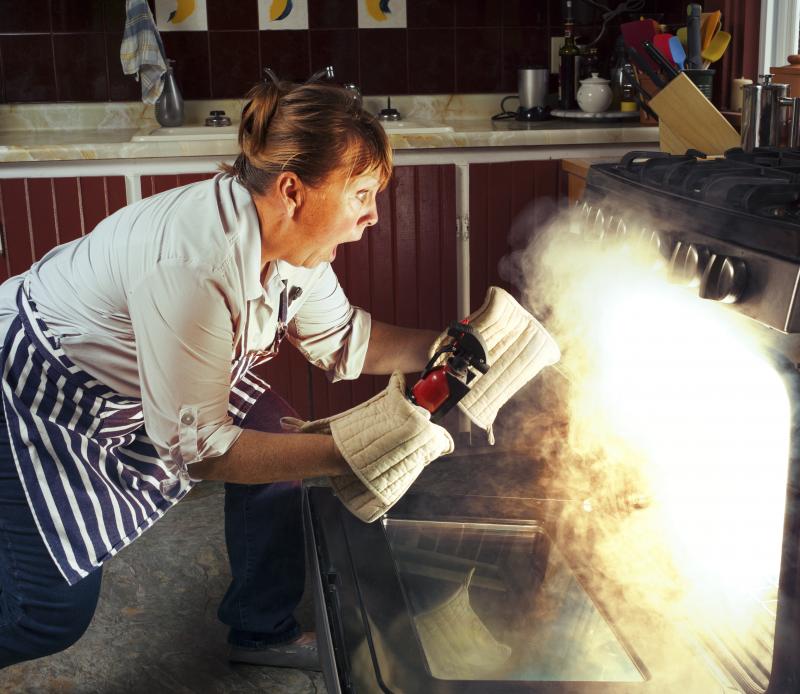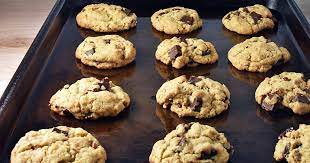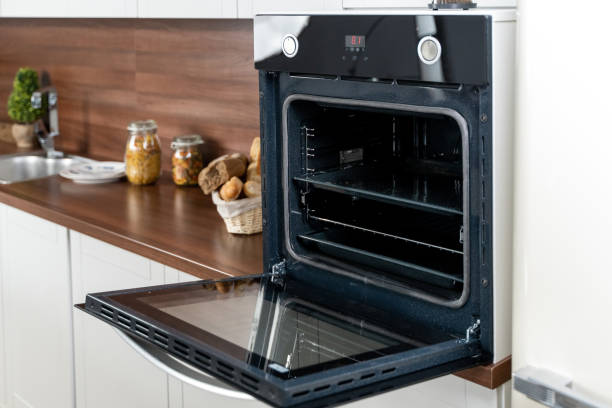Why Does the Bottom of My Oven Seem to be on Fire?

It’s all about finding the right balance when it comes to making a delicious dinner in the oven. To achieve the ideal texture and readiness in the oven, the inside of the dish must be properly cooked without the outside being burned. It’s also crucial that the outside of the cookie is thoroughly baked. The oven distributes heat uniformly from all sides, or you risk having a cookie that’s wonderfully soft on top but burnt beyond recognition on the bottom.
Reaching this sweet spot shouldn’t be too difficult with a working oven and a thermometer. However, whether you’re cooking in an oven that’s set up incorrectly or is malfunctioning, cooking the interior without scorching any part of the exterior is challenging.
Since you’re reading this, I’m guessing you’re going through it right now. Before you start doubting your abilities to complete a seemingly simple operation like baking a frozen pizza without it burning, take a close look at the equipment you’re using. The oven, in this scenario.
There is no one-solution-to-rule-them-all solution to this problem because various factors could cause it – but there is a reason why your oven burns your food towards the bottom, and we’ll figure out how to correct the imbalance.
The oven must be calibrated, or one of the heating components will fail because the thermostat or temperature sensor is faulty. An oven will usually burn the bottom (or one side) of the items you’re cooking.
Why Do Foods Burn on the Bottom of Your Oven?

I’ve already highlighted two of the most typical causes of this problem, and we’ll go over both in greater detail in a moment. Firstly, you should always be aware that there are a variety of different factors that might cause food to scorch towards the bottom. In this essay, we’ll go through all of them.
Let’s start with the reasons and then move on to the solutions.
The oven’s thermostat is malfunctioning.
If food is burning on one side of your oven, the thermostat has likely been damaged. The thermostat instructs the oven when to switch on and off the heating components, allowing the oven to maintain a consistent temperature. When a thermostat is broken or damaged, the elements may be switched on for an extended period, making it difficult to maintain the desired temperature.
If the thermostat’s communication with the heating element is faulty, the result will also be faulty. Purchase an external thermostat and take temperature readings in the oven to see if the thermostat gives the heating components the correct information. The temperature displayed on the external thermostat should be close to the oven’s specified setting.
One of the heating elements in the oven has been damaged.
If your food is burned on one side but only half-cooked or not cooked on the other, it’s possible that one of the oven’s heating elements has broken down. Most foods will be cooked from one side and receive very little heat distribution from the other side if there is only one working heating element, causing the dish to burn on one side long before the other side has finished cooking.
Over time, elements might burn out, and wiring can be damaged. This can render the heating element ineffective or lead it to behave abnormally, which you don’t want in the kitchen. Examine the heating elements to determine any obvious signs of wear or damage. Don’t avoid seeking professional assistance if you don’t feel safe or confident in your abilities.
When it comes to items like these, hiring a professional may be the best option. It’s simple to cause more harm than good if you don’t have the necessary expertise.
The oven hasn’t been calibrated yet
A miscalibrated oven is one of the most common causes of food scorching in the oven. When an oven isn’t properly calibrated, heat is distributed unevenly, heating the dish more from some angles than others. You’ll almost certainly wind up with a meal that’s half-cooked on the inside and crisp on the exterior.
There is no uniform method for calibrating an oven; instead, each model has its method. As a result, I recommend consulting your user manual or contacting customer service to learn how to re-calibrate your oven. Oh, and if you’ve long since thrown the user manual out the door, look it up online. There are numerous user manuals accessible as PDFs on the manufacturer’s website.
The oven trays are arranged incorrectly

Because the bottom heating element is closer to the tray than the upper element, if you set your oven trays on the lower end of the cavity, you’ll get more heat from it. Naturally, the bottom of the dish will cook faster than the top, increasing the risk of scorching.
The oven trays should be put on the center rack in most recipes. This is where the heat is dispersed most evenly, so your meals will be cooked evenly from all directions simultaneously. As expected, cooking near the heating elements will brown the side facing the elements faster than the opposite side.
Many ovens nowadays feature the heat source at the bottom. The heat source distributes the warm air, which allows it to rise and circulate throughout the oven cavity. Because the heat source is on the bottom of the oven, it’s critical to place the tray on the center rack - you want adequate heat from the source and heat from the warm air rising to the top.
You’re using the wrong pan or sheet.
You should set your food on a sheet with low thermal conductivity to avoid the bottom from burning. The stronger the material’s conductivity, the more likely it is to burn the bottom. If you use Pyrex, parchment paper, or a baking stone, you’re less likely to get a scorched bottom. Metallic materials have a higher conductivity and, as a result, are more dangerous.
You haven’t preheated the oven.
If you haven’t preheated the oven, your food will likely be exposed to direct heat from the oven’s heating elements for an extended period. Even if the heating elements are set to half-heat, additional exposure can make a difference. Preheat the oven and quickly place the dish in the oven once it is preheated.
You’re leaving the oven door open for an excessive amount of time

Keeping the oven door open may need the heating components to be switched on for an extended period to maintain the oven’s internal temperature. Simply turning on the elements for a few minutes longer than necessary may be the cause of scorching the bottom of your dish. The process of opening the door should be rapid and strategic.
Consider it a more relaxed version of Formula One’s pit stops.
You’re utilizing pans that are discolored, deformed, or drab in appearance.
These are regarded as “terrible pans” in this context. Using a bad pan (either broken or unfit for this purpose) will almost certainly result in your food burning on the bottom. If the pan causes the burning, lining it with parchment paper can help prevent and decrease it. Also, make sure the bottoms of your pans are clean and free of black spots, which might cause your food to burn.
So, how do you protect food from scorching on the bottom of the oven?
We recognize the issue, but what is the solution? No food should be thrown away, and by promoting awareness, we may reduce the quantity of food that ends up in landfills.
Check the temperature of your oven. Check if an external thermometer reads the same temperature as the oven.
- Preheat your oven and then set the food in it once it’s done preheating.
- Long lengths of time should not be spent opening the oven door.
- Make sure you’re using the right pans and sheets.
- Place the tray or rack in the middle of the oven, away from the top and bottom.
- Ensure that the oven is set to bake rather than broil.
- Make sure the heating elements aren’t damaged by visually inspecting them.
Test for hot spots: Place trays near your oven’s bake and broil elements (lower and top) to see whether there’s a temperature difference between them. Place a piece of bread in the center of each tray to check for equal cooking. If not, why not? Check the element that is causing the toast to burn.
What’s the Deal With My Overheated Oven?
An overheating oven is most commonly caused by a faulty thermostat or heating elements, but other factors could also cause it. Overheating your oven can be caused by several factors.
The temperature on the thermostat knob is incorrect: This indicates that the knob is not correctly fastened to the oven. As a result, determining the oven’s temperature was difficult, making it easier to overheat the oven.
Grime & Junk: It’s possible that the thermostat isn’t registering the oven’s temperature because it’s covered with grime. To see whether the oven stops overheating, remove the thermostat and clean it.
Oven fan: If the oven fan isn’t working properly or is running at a slow speed, it might cause the oven to overheat.
The control panel is malfunctioning: Most modern ovens have a control panel (a display). Power outages might cause problems with the control panel, causing it to malfunction. The circuit breaker may need to be switched off for a minute or two to reset the oven.
The selector switch is broken: The selector switch serves as a link between the heating components and the thermostat. The communication between these two units will be hampered if the selection switch fails. The selector switch may signal lower temperatures. As a result, it pushes the heating components to continue heating the oven even though it is already hot.
Other typical issues, such as broken thermostats, sensors, and heating elements, have previously been discussed in the article.











